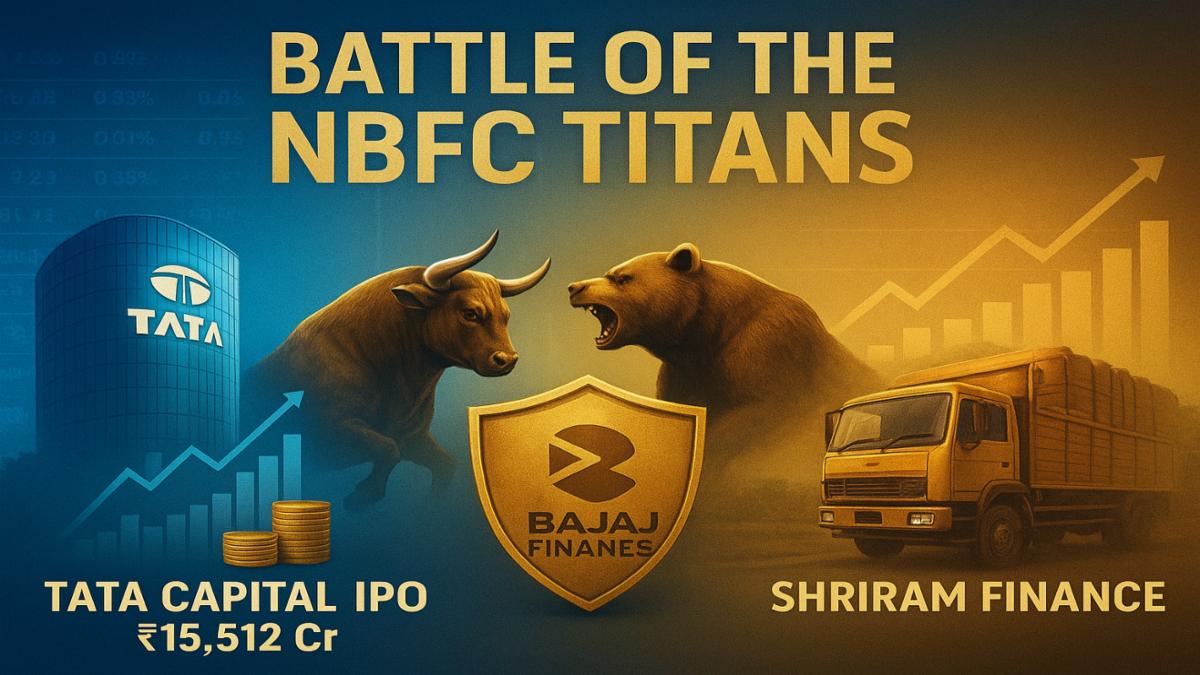Article Body
Battle of NBFC Titans: Can Tata Capital’s Mega IPO Rival Bajaj Finance and Shriram Finance?
Mumbai, October 6, 2025:
The Indian financial landscape is witnessing a defining moment as Tata Capital, the non-banking financial arm of the Tata Group, opens its much-anticipated ₹15,512 crore IPO for public subscription. For the first time since Tata Technologies’ blockbuster listing in 2023, the century-old conglomerate is returning to Dalal Street — and the buzz is deafening.
But beyond the excitement lies a sharper question that’s dividing investors and analysts alike:
Can Tata Capital truly compete with the established titans — Bajaj Finance and Shriram Finance — or is it just another shiny debut in India’s crowded NBFC space?
The New Contender: Tata Capital’s Grand Market Debut
Founded in 2007, Tata Capital has quietly evolved into India’s third-largest diversified NBFC, managing over ₹2.33 lakh crore in loans as of June 2025. With 87% of its portfolio rooted in retail and MSME lending — and a strong presence in housing and property loans — the company is strategically positioned at the intersection of India’s credit boom and the growing aspirations of middle-class borrowers.
The IPO, a mix of fresh equity and offer-for-sale, aims to bolster its Tier-I capital base, strengthen its retail book, and fund digital expansion. Priced between ₹310 and ₹326 per share, it positions Tata Capital at a market valuation of roughly ₹1.38 lakh crore.
“The listing is not just about raising funds — it’s about legacy,” said Vinit Bolinjkar, Head of Research at Ventura Securities. “After years of conservative growth, Tata Capital is now ready to play offense.”
The Benchmark: Bajaj Finance’s Reign of Consistency
If there’s one name synonymous with reliability in the NBFC universe, it’s Bajaj Finance. With assets under management (AUM) exceeding ₹4.4 lakh crore and over 10 crore customers, it remains the industry’s gold standard for disciplined growth and innovation.
Bajaj Finance’s Return on Equity (RoE) of nearly 19% and Net Interest Margin (NIM) of 9.9% highlight its operational efficiency and deep retail penetration. The company’s deposit franchise, product diversity, and digital ecosystem have allowed it to withstand market cycles with remarkable steadiness.
“Bajaj Finance is the benchmark every NBFC aspires to match,” said Abhinav Tiwari, an equity analyst with Bonanza Portfolio. “Its valuation premium reflects not just performance, but trust.”
However, that very premium — trading at nearly seven times book value — makes new investors wary. For those seeking fresh growth stories, Tata Capital’s entry offers an appealing alternative.
The Steady Player: Shriram Finance’s Grounded Growth
Occupying the middle ground is Shriram Finance, a powerhouse in vehicle and MSME lending. Following its merger with Shriram Transport and Shriram City Union Finance, it boasts an AUM of ₹2.7 lakh crore and a customer base nearing one crore.
With NIMs around 9.6% and a focus on underserved segments, Shriram Finance thrives on credit demand from India’s semi-urban and rural markets. Its RoE of 18.6% rivals Bajaj’s — though asset quality remains an area of close scrutiny, with Gross NPAs near 4.5%.
Analysts view Shriram as a “steady accumulator” — ideal for investors seeking consistency without the volatility of high-growth plays.
By the Numbers: Comparing the Titans
| Metric | Tata Capital | Bajaj Finance | Shriram Finance |
|---|---|---|---|
| AUM | ₹2.33 lakh crore | ₹4.44 lakh crore | ₹2.72 lakh crore |
| Net Profit (FY25) | ₹3,664 crore | ₹16,637 crore | ₹9,761 crore |
| NIM | 5.2% | 9.9% | 9.6% |
| RoE | 12.6% | 19.2% | 18.6% |
| RoA | 1.8% | 2.2% | 4.3% |
| Branches | 1,516 | 4,192 | 3,225 |
| Customers | 0.73 crore | 10.6 crore | 0.97 crore |
While Bajaj leads across profitability and scale, Tata Capital’s post-IPO infusion could narrow the gap by improving its capital adequacy and lending agility. Shriram, meanwhile, remains a strong regional player with deep distribution roots.
Investor Dilemma: Growth or Stability?
For market veterans, this battle is as much about philosophy as finance.
-
Bajaj Finance represents stability and compounding returns — a fortress stock for the long term.
-
Tata Capital offers momentum and potential re-rating — a bet on growth, efficiency, and the Tata brand’s credibility.
-
Shriram Finance sits in between — a diversified, steady compounder that appeals to value-seekers.
“The Tata name commands trust, and the IPO could attract retail investors looking for a blend of brand strength and upside potential,” said Shruti Jain, Chief Strategy Officer at Arihant Capital Markets. “But Bajaj Finance remains unmatched in execution, and Shriram holds the pulse of Bharat.”
The Broader Picture: India’s NBFC Boom
India’s NBFC sector is in the midst of a structural expansion. As banks tighten lending norms and digital credit adoption rises, non-banking lenders are capturing a growing share of personal, MSME, and consumer finance segments.
According to CRISIL, NBFCs could see loan growth of 14–16% CAGR over the next three years, driven by urban consumption and rural infrastructure funding.
Within this context, Tata Capital’s listing isn’t just another IPO — it’s a signal that the Tata Group is ready to challenge incumbents in one of India’s fastest-growing financial segments.
Expert Take: A Three-Way Race with Different Speeds
-
For long-term investors: Bajaj Finance remains the safest bet with its strong brand moat and stable performance.
-
For short- to medium-term investors: Tata Capital offers the highest growth potential as its valuation gap could narrow rapidly post-listing.
-
For conservative players: Shriram Finance provides a balance of yield and stability, though asset quality must be watched.
As market veteran Vinit Bolinjkar summarized, “This is a three-speed race — Bajaj is cruising, Tata is accelerating, and Shriram is pacing steadily. The winner depends on your investment horizon.”
Conclusion: Tata Capital’s IPO — A New Chapter in India’s Financial Evolution
Whether or not Tata Capital dethrones Bajaj Finance anytime soon, its IPO has already achieved something remarkable: it has reignited investor interest in the NBFC sector. With India’s credit appetite growing and capital markets deepening, this battle of financial titans represents not just competition — but the coming-of-age of India’s non-banking finance ecosystem.
For now, all eyes are on October 8 — when the subscription closes and the numbers reveal whether investors are ready to bet on Tata’s next big leap.


Comments